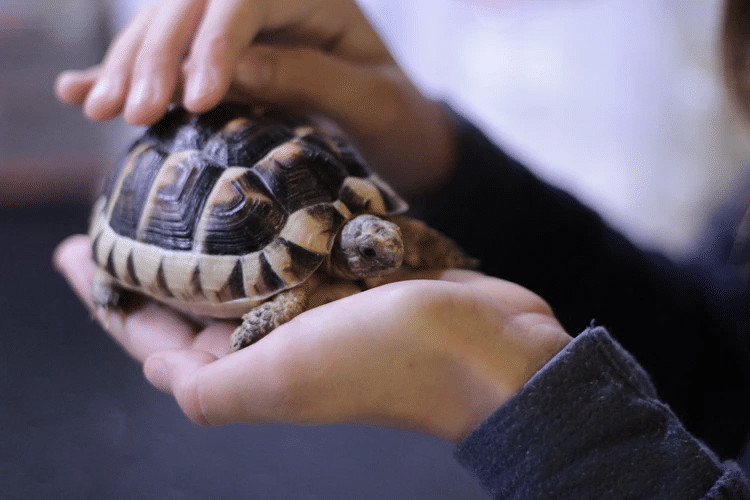Just as you would consider dog breeds when getting a new puppy, you should consider the different species of tortoises, too, before welcoming one to your home. Different tortoises have different needs, different personalities, and will grow to different sizes. These are all things you should take into consideration before choosing which pet tortoise is best for you.
Which tortoise breeds make the best pets is going to be different for everyone so here is some insight to help you make the right decision.
Before you Get a Tortoise
Before you consider getting a pet tortoise and, more importantly, which species of tortoise you want to get, you should have a think about the following things.
Habitat
When choosing a tortoise you should think about their native habitat and what kind of environment you can provide for them, as well as what exactly is recommended for each species.
Outdoors
Where are you planning on keeping your tortoise? If you want to keep your pet tortoises outside in your garden then you should plan on getting a species that is suited for the UK weather. Species like leopard tortoises and the Indian star tortoise should not be kept outside as they are not tolerant to the cold at all. Meanwhile, other species of tortoise can be kept outside as they are able to survive in lower temperatures.
It’s still important that the temperature stays within a range that is safe for them though, and remember that it can get a lot colder at night!
If you are keeping your tortoise outside it will almost certainly need a run, to ensure it doesn’t escape. But It is also important to think about their natural behaviours; some pet tortoise species such as marginated tortoises and sulcata tortoises love to burrow therefore you will need to manage any potential risks of escaping underground, too.
Indoors
If you do choose to keep your tortoise indoors then you will need to provide a suitable enclosure with the correct substrate, food and water requirements, as well as ample sources of warmth and UV light.
Most tortoise owners will buy or make a wooden tortoise table so make sure you get one that is big enough for the needs of your tortoise. Alternatively, some people are lucky enough to be able to dedicate a whole room to their pet tortoises where they can keep larger species such as the sulcata or African spur-thighed tortoise that you wouldn’t normally be able to keep in a tortoise table for very long.
Wherever you keep them, you should make sure that they cannot escape and that they are safe from pests, predators, and toxic substances.
Size
Another thing to take into consideration when building a tortoise enclosure is the space requirements. It is recommended that large species such as the sulcata tortoise have at least 80 squared feet for them to explore. If you don’t have this kind of space to dedicate to your pet tortoise, maybe it’s best you get a smaller species like an Egyptian or pancake tortoise that would be comfortable in a tortoise table.
Brumation
If you are keeping your tortoise in an outdoor enclosure and the temperatures do drop below their desired range, as they likely will in the UK, then be prepared for your tortoise to hibernate. Consult with a specialist veterinarian and do lots of research to make sure your tortoise is in the best health to survive this period.
Health
Tortoises are prone to several health conditions that any tortoise owner needs to be aware of. Before getting a tortoise, have a look in your local area to see if there are any specialist veterinarians that can help you with your exotic pet if something were to go wrong. Not all vets will be able to provide the care you need if your pet tortoise were to develop a problem.
Things to be aware of include respiratory infections and metabolic bone disease. Although avoidable, and often treatable, these illnesses are still very common in captive tortoises.
Personality
The best pet tortoises are often those that enjoy human interaction, as that’s why most people will get a pet in the first place. Some tortoises may not like being handled as much as others, while others will get too big to be handled at all! The most interactive tortoises include red-footed and African spur-thighed tortoises and will often seek out their owners for positive interactions.
Red-footed and Hermann’s tortoises are also known for their curious and docile natures which make them great for first-time tortoise owners. Alternatively, leopard star tortoises are known to be quite shy in nature so are more likely to seek shelter when you come near.
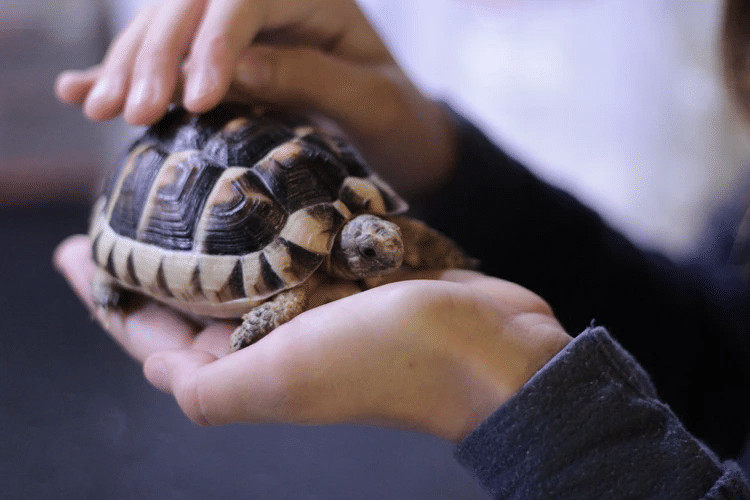
Having More Than One Tortoise
You should also think about tortoise’s personalities if you are considering having more than one tortoise. Two males should not be kept together as it can cause territorial behaviours that can result in fights and injuries. Males and females together can work as long as you make sure the male does not bother the female too much.
The best combination would be to get more than one female as you are less likely to have any issues. However, wild tortoises are not considered to be social animals so they are more than happy to be solitary creatures and not share their space with any other tortoises at all.
Lifespan/Age
Unlike other pets, most pet tortoises can outlive their tortoise keepers when given the right care so you will need to think about what will happen to your tortoise when you are no longer able to look after them. Many tortoises live up to 75 years old, some even longer.
Food and Water
Their diets are usually quite easy to cater for and include leafy greens, vegetables and small amounts of fruit, but do your research to know which foods are toxic for them before letting them out into your garden to graze on the natural flora.
Different species can eat different things, but if you are unsure you can always buy a pelleted diet that is specially formulated for some of the more popular tortoise breeds.
Also, make sure they are provided with a shallow water bowl that they can drink from and easily climb in and out of.

Legal Restrictions
Certain tortoise species such as the Greek tortoise, marginated, and Hermann’s tortoise are all classed as endangered therefore they require a permit in the UK. Due to their status as endangered animals, the Article 10 certificate ensures that they are not illegally caught in the wild and imported to the UK, thus preserving the wild populations.
There are two types of Article 10 certificates: the Transaction Specific Certificate (TSC) and the Specimen Specific Certificate (SSC).
The TSC is for young tortoises that are under 60mm in size and too small to microchip. The breeder or seller should be named on the certificate and you, as a tortoise owner, should ask to see this certificate and take a photocopy, too.
The SSC will have the microchip of your tortoise and should stay with the tortoise for the entirety of its life, meaning you should be given it when you buy your new pet.
Which Tortoise Should You Get?
So now you know everything you should consider before getting a pet tortoise, you should be one step closer to knowing which species is a good fit for you. Here’s everything you need to know about some of the most popular species to ease you into tortoise ownership.
Mediterranean Spur-Thighed Tortoise
Alternative names: Greek tortoise
Scientific name: Testudo graeca
Conservation Status: Vulnerable
Adult Size: 10-inches
Lifespan: 50 years (but have been known to live up to 125 years old)
Recommended space requirements: min. 18 square ft
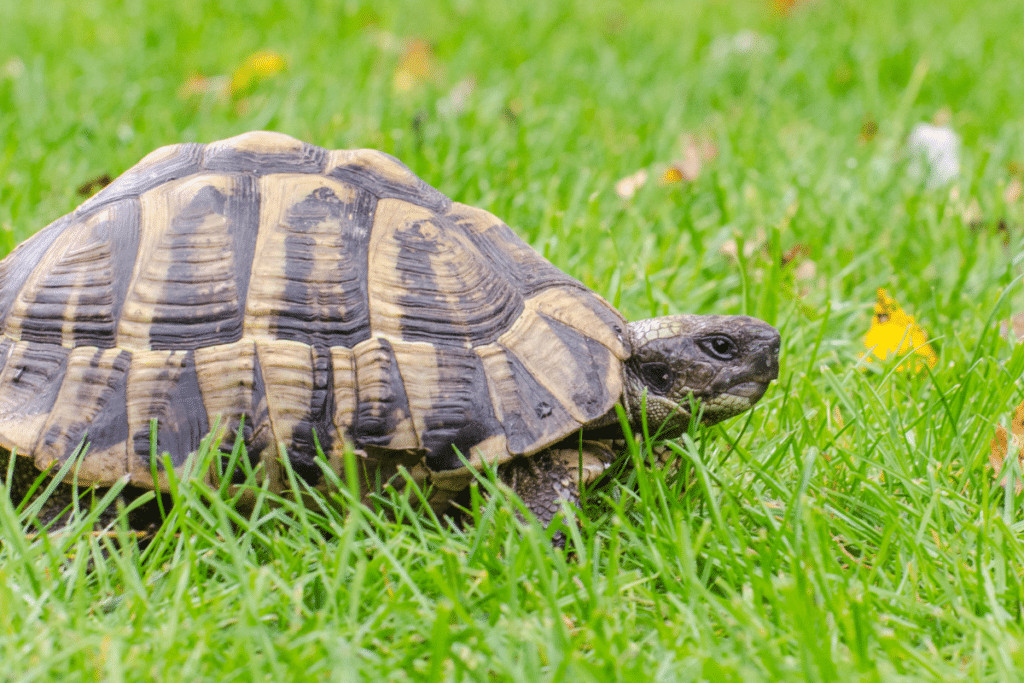
Spur-thighed tortoises are given their name due to the raised scales that are present on the inside of their thighs. They are also known for the symmetrical markings on their head and the range of colours present in their shells.
The Greek tortoise is one of the most popular species due to its smaller size and curious nature. They do not like being handled however they are known to be very friendly with their owners.
They don’t require too much space but be sure to give them some natural, tortoise-safe plants, and a good substrate.
Leopard Tortoise
Scientific name: Stigmochelys pardalis
Conservation Status: Least concern
Adult Size: average 18-inches
Lifespan: up to 100 years in the wild
Recommended space requirements: min. 50 square feet however larger is better and many will offer over 80 square feet

The leopard tortoise is well known for its stunning shell that resembles the spotted cat that they are named after.
Leopard tortoises are the 4th largest tortoise species in the world. These docile creatures make wonderful pets however, due to their larger size, they require a lot more space than many people can provide. They thrive in outdoor environments however they are not tolerant of the cold therefore do not do well in UK weather, especially at night.
These large tortoises don’t like to dig or climb so they just need a secure space to be able to graze and explore.
Red-Footed Tortoise
Scientific name: Chelonoidis carbonaria
Conservation Status: Vulnerable
Adult Size: 11-14 inches
Lifespan: 30-50 years
Recommended space requirements: min 50 square feet

Considered a medium-sized tortoise, the red-footed tortoise is easily distinguishable by the red colourings on its feet and sometimes head, hence the name.
Red-footed tortoises need higher levels of humidity than other tortoises however many tortoise owners say the extra effort is well worth it for their inquisitive nature. The red-footed tortoise rarely shies away from humans which is why they are considered to be one of the best tortoise species to be kept as pets.
Indian Star Tortoise
Alternative names: Star tortoise
Scientific name: Geochelone elegans
Conservation Status: Vulnerable
Adult Size: up to 12 inches
Lifespan: 30-80 years
Recommended space requirements: min. 36 square feet
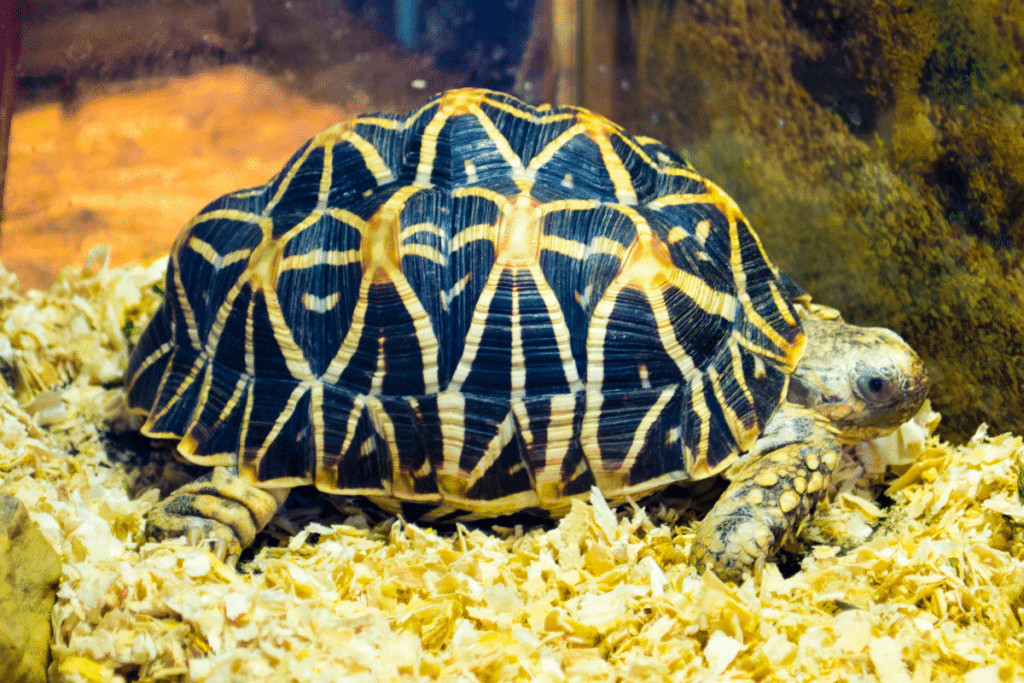
Indian star tortoises have incredible markings on their shells that are unlike any other, making them a popular pet across the globe. Most tortoises have a range of colour variations on their shells, but the Indian star tortoise has just dark and bright, making a stunning contrast, and an instantly recognisable appearance.
They love to soak in water so provide them with a shallow bowl, but make sure they have a dry substrate to prevent respiratory infections. They’re also not known for their climbing or digging skills so no need to worry as much about them being escape artists.
These tortoises are quite shy so don’t expect them to openly interact with you; be calm and patient and they’ll warm up to you eventually.
African Spur-Thighed Tortoise
Alternative names: Sulcata tortoise, African spurred
Scientific name: Geochelone sulcata
Conservation Status: Vulnerable
Adult Size: 36-inches
Lifespan: 70+ years
Recommended space requirements: min. 50 square feet

Growing up to 36 inches in length, the African spurred tortoise is one of the largest species of tortoises in the world. As they are commonly captive bred, they are common pets and relatively inexpensive to buy, however, this makes it even more important to buy them from a reputable breeder.
As a young tortoise, you can expect your sulcata tortoise to be shy at first, but as they grow older they are known to be one of the most interactive tortoises with their owners. They can also be quite destructive so be prepared when setting up their enclosure.
Due to their large size, they are better suited to a large outdoor enclosure or an entire room of the house for them to roam around in. Although they can tolerate lower temperatures, once it gets to 15C you should consider moving them inside and providing them with additional heat. These tortoises love to burrow so you should secure their enclosure at least 2m below the ground.
Marginated Tortoise
Scientific name: Testudo marginata
Conservation Status: Vulnerable
Adult Size: 12-15 inches
Lifespan: 100-140 years
Recommended space requirements: min. 16 square feet
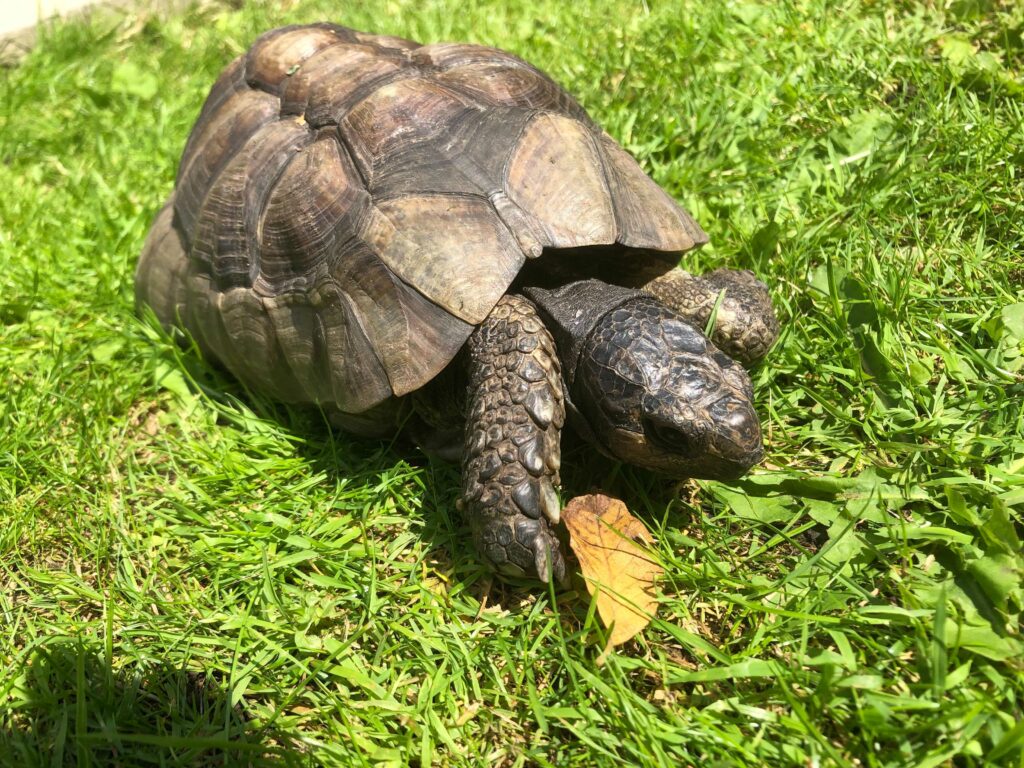
The marginated tortoise loves to climb so the walls of their enclosure need plenty of height, or a roof so that they cannot climb out. They also dig, too, so if you choose to house them outside then the walls need to be sunken into the ground to prevent escape.
When in their natural habitat, the marginated tortoise does like to roam therefore if you can offer more space than the minimum recommended then you definitely should!
With such a long lifespan, be sure to consider them when you are no longer able to care for your beloved pet.
Russian Tortoise
Alternative names: Horsfield tortoise, Afgan tortoise, Central Asian tortoise
Scientific name: Agrionemys horsfieldii
Conservation Status: Vulnerable
Adult Size: up to 10-inches
Lifespan: 40+ years
Recommended space requirements: min. 8 square feet
Russian tortoises are known to be a hardy species, therefore, making an easy pet tortoise for beginners. They are also more active than other species which is another bonus of having them as a pet!
The Russian tortoise loves to burrow so you should provide plenty of substrate if they are housed in a tortoise table, or be sure to prevent any escapes under the walls if they are housed outside.
Their diets are much more specific than other species therefore make sure you thoroughly research the foods that they can and cannot eat.
Hermann’s Tortoise
Scientific name: Testudo hermanni
Conservation Status: Near threatened
Adult Size: 8-inches
Lifespan: 50+ years
Recommended space requirements: min. 16 square feet

There are several subspecies including the western Hermann’s tortoise which is one of the smallest pet tortoises available. The eastern Hermann’s tortoise is a little larger and grows up to 11-inches in length.
Hermann’s tortoises are very commonly kept as pets but must be kept in enclosures with high walls as they, as other species do, enjoy climbing therefore can easily escape if given the opportunity. This also means you should give them provide them with lots of enrichment in their enclosure such as plants and rocks, so that they don’t get bored.
These small tortoise species are docile yet are very active and will readily interact with their owners.
Egyptian Tortoise
Alternative names: Kleinmann’s tortoise, Leith’s tortoise
Scientific name: Testudo kleinmanni
Conservation Status: Critically endangered
Adult Size: 5-inches
Lifespan: 70-100 years
Recommended space requirements: min. 4 square feet

Due to their small size, Egyptian tortoises do great in tortoise tables as they do not require too much space. But don’t get complacent as they still require the correct temperature, substrate, and diet, amongst other things, to be able to live a happy and healthy life.
Although they are considered critically endangered in the wild, there is a thriving captive-bred population meaning they are still popular pets around the world.
Despite their natural habitat being dry, they are prone to dehydration therefore should be bathed a couple of times a week and given access to fresh water in their enclosure. What’s more, they also are less tolerant of temperature changes and thrive in a warm environment so be sure to have the proper equipment to maintain and monitor their conditions.
Where Do I Buy a Tortoise?
There are many places in the UK that you can buy tortoises from, but be sure it is from a reputable breeder that provides adequate care and breeds responsibly. The tortoise protection group can offer advice on where to go to get your pet tortoise, and where not to go.
Getting Your Tortoise
Choosing a tortoise is a big decision to make, besides, it will be with you for many years to come! Be sure that you can provide it with everything that it needs to survive; although a large tortoise would be a cool friend to have, if you don’t have the space then it’s much kinder to get something smaller in size.
Let us know what kind of tortoise you have!




